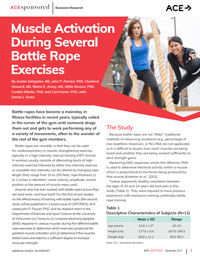Muscle Activation During Battle Rope Exercises
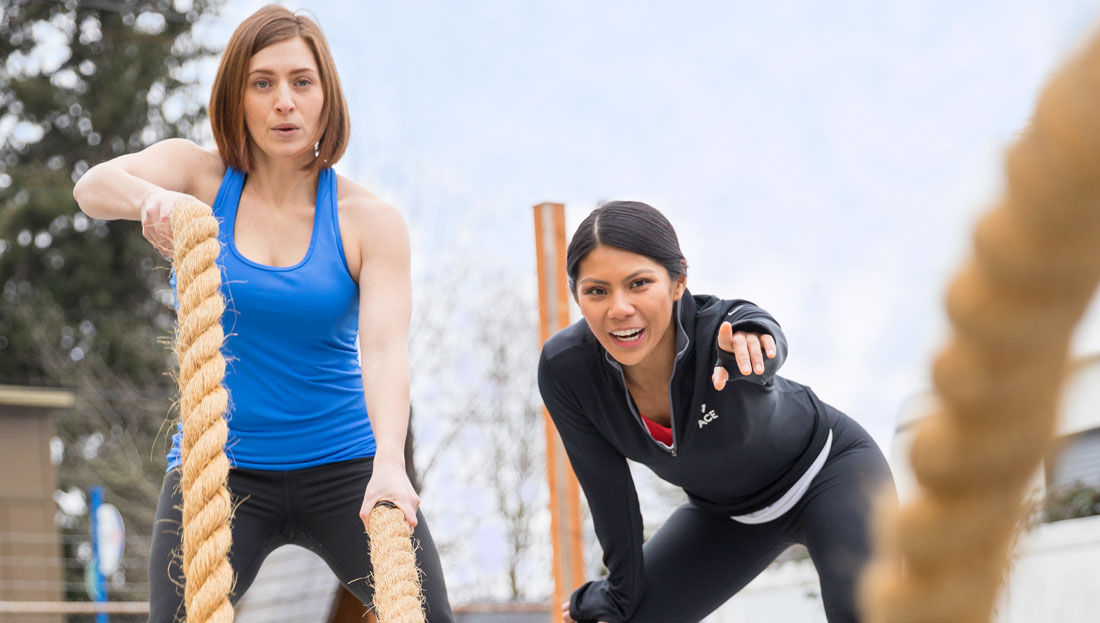
Austin Salzgeber, MS, John P. Porcari, PhD, Charlend Howard, MS, Blaine E. Arney, MS, Attila Kovacs, PhD, Cordial Gillette, PhD, and Carl Foster, PhD, with Daniel J. Green
Battle ropes have become a mainstay in fitness facilities in recent years, typically coiled in the corner of the gym until someone drags them out and gets to work performing any of a variety of movements, often to the wonder of the rest of the gym members.
Battle ropes are versatile, in that they can be used for cardiorespiratory or muscle-strengthening exercise, typically in a high-intensity interval training (HIIT) format. A workout usually consists of alternating bouts of high-intensity exercise followed by either low-intensity exercise or complete rest. Intensity can be altered by changing rope length (they range from 10 to 100 feet), rope thickness (1 to 2 inches in diameter), wave velocity, amplitude, anchor position or the amount of muscle mass used.
Anyone who has ever worked with battle ropes knows they are hard work—but how hard? For this first of two studies on the effectiveness of training with battle ropes (the second study will be published in a future issue of CERTIFIED), ACE asked John P. Porcari, PhD, and his research team in the Department of Exercise and Sport Science at the University of Wisconsin–La Crosse to (1) compare electromyographic (EMG) response in various muscles during five different battle rope exercises to determine which exercises produced the greatest muscle activation and (2) determine if the muscles tested were activated to a sufficient degree to increase muscular strength.
The Study
Because battle ropes are not “lifted,” traditional methods of measuring resistance (e.g., percentage of one-repetition maximum, or %1-RM) are not applicable, so it is difficult to assess how much muscles are being taxed and whether they are being worked sufficiently to elicit strength gains.
Measuring EMG responses solves this dilemma. EMG is used to determine electrical activity within a muscle, which is proportional to the forces being produced by that muscle (Kraemer et al., 2002).
Twelve apparently healthy volunteers between the ages of 20 and 24 years old took part in this study (Table 1). They were required to have previous experience with resistance training, preferably battle rope training.
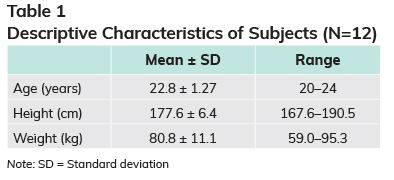
Each subject participated in one practice session, during which the battle rope exercises were demonstrated and the subjects were given time to practice. All exercises were performed with feet shoulder-width apart, knees slightly bent, back straight, a slight forward lean of the torso, elbows extended, and handles held with a handshake grip. Exercises were performed at a self-selected pace, but the subjects were told to perform the exercises as vigorously as possible.
The following five exercises were performed:
- Double-arm slams: The subject brought both ends of the battle rope near or above their head with shoulder flexion. Forceful shoulder extension occurred to cause the battle rope to hit the ground as hard and fast as possible.
- Double-arm waves: The subject held both ends of the battle rope. The subject kept his or her arms in front of the torso by flexing the shoulders until the battle rope handles were approximately shoulder height, and then extended the shoulders until the handles were even with the waist. The arms moved up and down in unison.
- Double alternating arm waves: The subject held both ends of the battle rope. The subject kept the arms in front of the torso by flexing the shoulders until the battle rope handles were approximately shoulder height, and then extended the shoulders until the handles were even with the waist. The subject alternated the extension and flexion of each shoulder with each arm, so the arms moved in opposite directions.
- Single-arm waves: The subject held one end of the battle rope with a single arm. The subject flexed the shoulder until the battle rope handle was approximately shoulder height, and then extended the shoulder so the handle was approximately waist height.
- Double outside circles: The subject held both ends of the battle rope, and the handles stayed near the abdominal region throughout the exercise. The subject slightly raised and externally rotated both shoulders in a circular motion and then internally rotated both in a circular motion. The circles being made by the arms going in opposite directions.
On the testing day, the subjects performed an active warm-up consisting of five minutes on a stationary bike and three minutes of battle rope exercises. After having electrodes placed on various muscles, they performed a maximum voluntary isometric contraction (MVIC) for each muscle using manual muscle techniques (i.e., the subjects were asked to contract with as much force as possible against an immoveable object, which gives the research team a maximal EMG reading for that particular muscle).
The eight muscles evaluated in this study were as follows:
- Vastus medialis
- Gluteus maximus
- Erector spinae
- External oblique
- Rectus abdominis
- Upper trapezius
- Anterior deltoid
- Palmaris longus
The subjects then performed the five battle rope exercises described above.
The Results
Muscle activation for each of the eight muscles during each exercise is presented in Figures 1 through 8. The muscle activation data were compared to a threshold of 40% of MVIC, as it is generally accepted that a muscle must be contracting above 40% MVIC in order to gain strength (Fry, 2004).

Figure 1. Activation of the vastus medialis for the five battle rope exercises. Dashed line depicts threshold for increasing muscular strength. *Statistically significantly greater than all other exercises (p<.05).
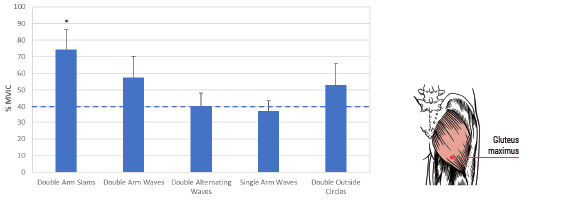
Figure 2. Activation of the gluteus maximus for the five battle rope exercises. Dashed line depicts threshold for increasing muscular strength. *Statistically significantly greater than all other exercises (p<.05).

Figure 3. Activation of the erector spinae for the five battle rope exercises. Dashed line depicts threshold for increasing muscular strength. *Statistically significantly greater than all other exercises (p<.05).
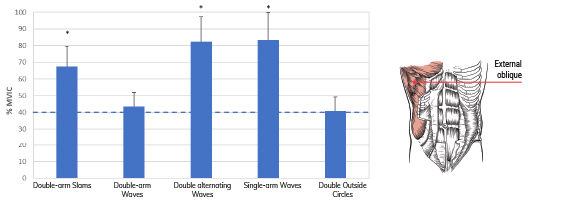
Figure 4. Activation of the external oblique for the five battle rope exercises. Dashed line depicts threshold for increasing muscular strength. *Statistically significantly different than Double-arm Waves and Double Outside Circles (p<.05).
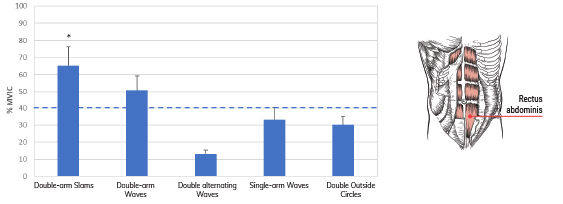
Figure 5. Activation of the rectus abdominis for the five battle rope exercises. Dashed line depicts threshold for increasing muscular strength. *Statistically significantly greater than all other exercises (p<.05).

Figure 6. Activation of the upper trapezius for the five battle rope exercises. Dashed line depicts threshold for increasing muscular strength.
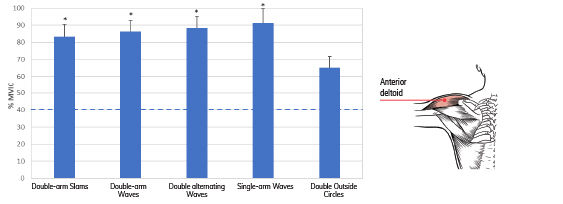
Figure 7. Activation of the anterior deltoid for the five battle rope exercises. Dashed line depicts threshold for increasing muscular strength. *Statistically significantly greater than Double Outside Circles (p<.05).
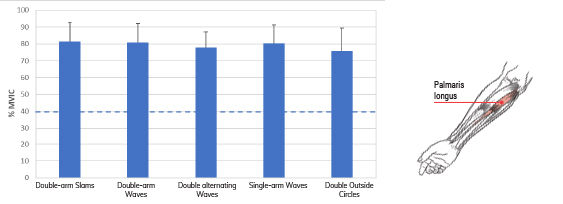
Figure 8. Activation of the palmaris longus for the five battle rope exercises. Dashed line depicts threshold for increasing muscular strength.
The findings of this study can be summarized as follows:
- All eight muscles tested were contracting above 40% MVIC during double-arm slams and double-arm waves.
- All of the muscles were contracting above 40% MVIC during double alternating waves, except for the vastus medialis and the rectus abdominis.
- All of the muscles were contracting above 40% MVIC during double outside circles, except for the rectus abdominis and anterior deltoid.
- All of the muscles were contracting above 40% MVIC during single-arm waves, except for the vastus medialis, gluteus maximus and the rectus abdominis.
- The vastus medialis, gluteus maximus, erector spinae and rectus abdominis worked significantly harder during double-arm slams than during any of the other exercises.
- The external oblique worked significantly harder during double-arm slams, double alternating waves and single-arm waves than during double-arm waves and double outside circles.
- The anterior deltoid worked significantly harder during double-arm slams, double-arm waves, double alternating waves and single-arm waves than during double outside circles.
- For the upper trapezius and palmaris longus, there were no significant differences among the exercises.
- It should be noted that for the erector spinae, data were only available for nine subjects due to technical difficulties.
Dr. Porcari nicely summarizes these complex and extensive results: “Battle ropes provide a tremendous total-body workout, but variety of movement is key.”
The Bottom Line
The main purpose of this study was to determine if battle rope exercises can overload the muscles enough to improve muscular strength. With a few exceptions, most of the muscles were contacting at or above the 40% MVIC threshold for the majority of the exercises.
If someone had to choose a single battle rope exercise to include in his or her training, double-arm slams would be the optimal choice, as it was the best exercise for activating the majority of the muscles tested. This is because there is more vertical motion of the entire body, as the subjects brought the battle rope above their heads and then forcefully slammed the rope into the ground. Also, exercise with the battle rope was shown to positively affect grip strength, as reflected by the fact that the palmaris longus was contracting in excess of 75% of MVIC during all exercises.
This research confirms that battle rope exercises may be a great addition to a client’s workout program and offer a full-body training regimen that is fun and challenging. So, encourage your clients to uncoil those ropes and take advantage of this versatile and effective workout tool.
References
Fry, A. (2004). The role of resistance exercise intensity on muscle fibre adaptations. Sports Medicine, 34, 663–679.
Kraemer, W.J. (2002). American College of Sports Medicine position stand: Progression models in resistance training for healthy adults. Medicine & Science in Sports & Exercise, 34, 364–380.
Interested in more battle rope exercises? Check out this Total-body Battle Ropes Workout, which includes a warm-up and nine exercises.





